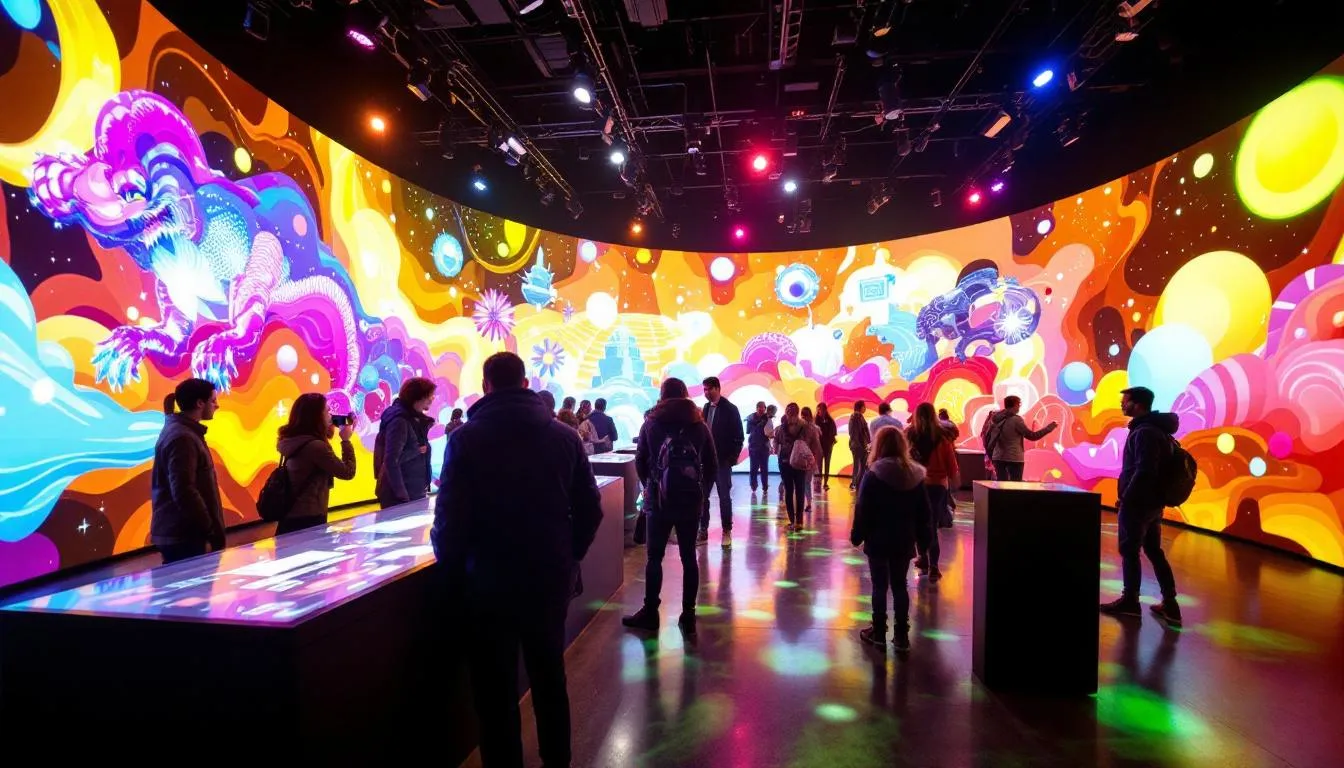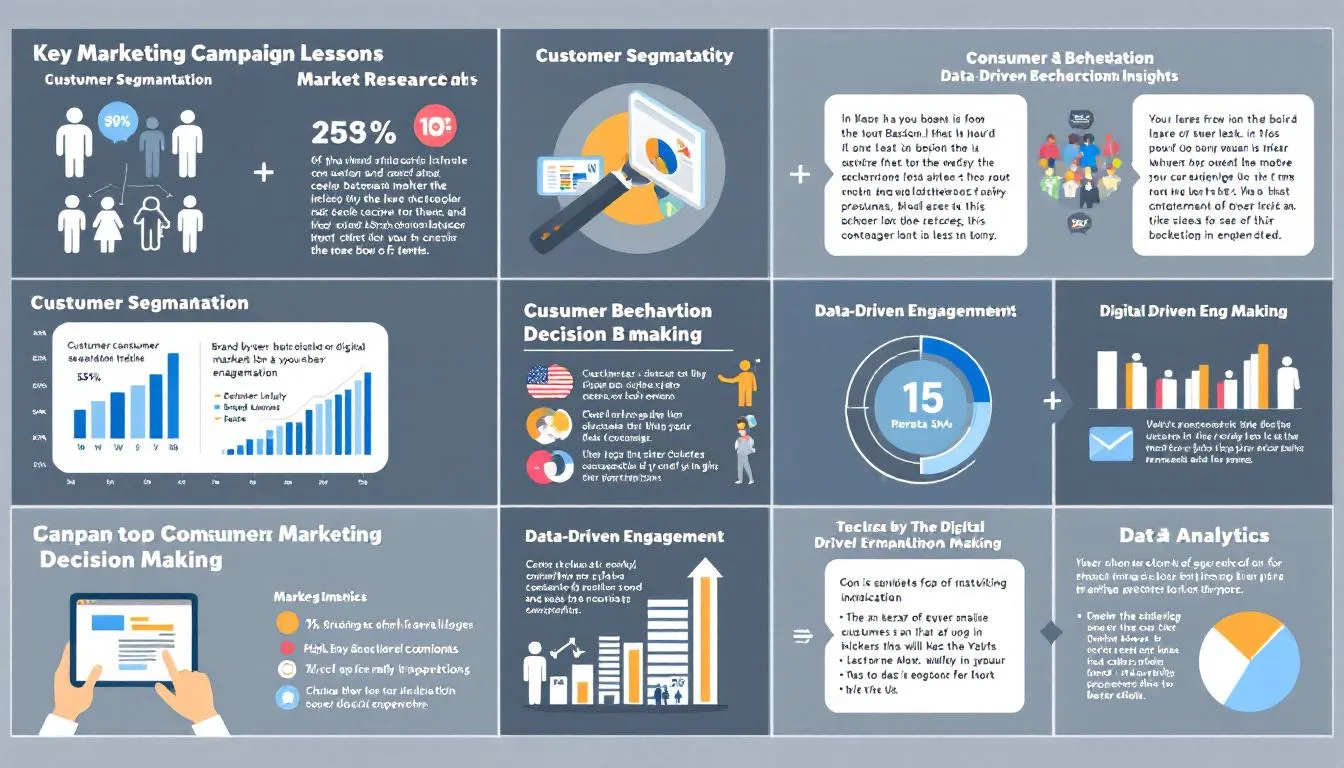In 2023, businesses spent over $760 billion on advertising worldwide, yet only a fraction of marketing campaigns achieve true cultural impact. The difference between a forgotten ad and a campaign that changes entire industries often comes down to understanding what makes marketing truly resonate with audiences. Data plays an important role at every stage of a marketing campaign, from audience understanding to campaign analysis, ensuring strategies are both informed and effective.
Popular marketing campaigns don’t just sell products—they create movements, spark conversations, and become embedded in our collective consciousness. From Nike’s revolutionary “Just Do It” to the recent Barbie movie phenomenon, these campaigns demonstrate the power of strategic creativity combined with deep audience understanding.
This comprehensive analysis examines 25+ iconic marketing campaigns that transformed their respective industries and provides actionable insights for creating your own memorable marketing efforts. You’ll discover the strategies, tactics, and creative approaches that turned simple advertising into cultural touchstones.
What Makes Popular Marketing Campaigns Truly Effective
The most successful marketing campaigns share several key characteristics that separate them from ordinary advertising efforts. Understanding these elements is crucial for any marketing strategy aiming to achieve widespread recognition and lasting impact.
Memorable messaging
It forms the foundation of every great marketing campaign. The best marketing campaigns distill complex brand values into simple, repeatable phrases that stick in consumers’ minds. These messages transcend traditional advertising by becoming part of everyday language and pop culture references.
Emotional connection
It drives campaign virality more than any other factor. Popular campaigns tap into universal human experiences—hope, nostalgia, humor, or aspiration—creating bonds between brands and their target audience that extend beyond product features. For example, Apple's 'Shot on iPhone' campaign features user-submitted photos, showcasing the iPhone's camera quality and leveraging user-generated content for authentic marketing. This emotional resonance transforms casual viewers into brand advocates who willingly share content across their networks.
Cultural relevance
It ensures campaigns resonate with current social conversations and trending topics. The most impactful marketing efforts either anticipate cultural shifts or respond authentically to existing movements, positioning brands as relevant participants in broader societal discussions. Volkswagen's "Think Small" campaign, for example, acknowledged the VW Beetle's small size as a strength, using witty, minimalist messaging to appeal to a new generation and align with cultural trends of simplicity and practicality.
Shareability
It has become essential in our digital age. Popular campaigns are designed from the ground up to encourage social media engagement, user generated content, and organic amplification. They provide audiences with compelling reasons to interact, comment, and redistribute content within their own communities.
The distinction between popular and successful campaigns is important to understand. While successful campaigns achieve their business objectives—increased sales, brand recognition, or market share—popular campaigns transcend commercial goals to become cultural phenomena. They generate earned media coverage, inspire parodies and tributes, and maintain relevance long after their initial launch. Marketers are increasingly using personalized marketing messages to cater to individual consumer preferences, ensuring campaigns resonate on a deeper level with their audiences.
Essential elements that drive campaign popularity include crystal-clear target audience definition, compelling storytelling that goes beyond product promotion, and consistent branding across various channels. Popular campaigns also demonstrate remarkable timing, launching when audiences are most receptive to their core message.

Best Marketing Campaign Examples That Defined Generations and Shaped Marketing Strategy
Some marketing campaigns achieve such profound impact they fundamentally reshape how entire industries approach advertising. These classic campaigns continue influencing marketing strategy decades after their initial launch, proving the lasting power of exceptional creative execution. For instance, Red Bull sponsored Felix Baumgartner's record-breaking jump from the stratosphere, creating a major cultural moment and challenging the status quo.
Nike “Just Do It” (1988)
It revolutionized athletic marketing by shifting focus from product features to personal motivation. The campaign’s genius lay in making Nike synonymous with determination and achievement rather than specific shoe technology. This approach helped Nike transform from a running shoe company into a global lifestyle brand, increasing their market share from 18% to 43% within a decade. Similarly, Apple's 1984 Super Bowl commercial introduced the Macintosh computer using a cinematic narrative inspired by George Orwell's Nineteen Eighty-Four, setting a new standard for storytelling in advertising.
The campaign’s emotional connection strategy centered on showcasing ordinary people achieving extraordinary things, making the brand identity accessible to millions who aspired to push their personal limits. This positioning created such strong brand recognition that “Just Do It” became more than advertising—it became a cultural rallying cry for personal achievement.
Coca-Cola “Share a Coke” (2011)
It demonstrated the power of personalization before it became a standard marketing tactic. By replacing their iconic logo with popular names on bottles and cans, Coca-Cola created a marketing campaign that drove massive social media engagement while increasing sales by 2.5% globally.
The campaign’s success stemmed from understanding that consumers crave personal recognition and connection. When people found their names or searched for friends’ names, they became active participants in the marketing strategy rather than passive recipients. This user generated content approach generated millions of social shares and transformed product packaging into personalized gift items.
Apple “Think Different” (1997)
It repositioned Apple during its most challenging period by celebrating creativity and innovation rather than technical specifications. The campaign featured iconic figures like Einstein, Gandhi, and Picasso, associating Apple with revolutionary thinking and creative pursuits.
This brand positioning strategy helped Apple rebuild its brand identity around innovation and artistic expression, setting the foundation for future product launches. The campaign proved that effective branding could create emotional connections even when specific products weren’t featured prominently in advertisements.
McDonald’s “I’m Lovin’ It” (2003)
It created the first truly global McDonald’s marketing campaign, unifying diverse international markets under a single brand message. The jingle became instantly recognizable across cultures, demonstrating how effective audio branding transcends language barriers.
The campaign’s success in reaching a global target audience while maintaining local relevance showed how multinational brands could achieve consistency without sacrificing cultural sensitivity. This approach helped McDonald’s strengthen its position as the world’s leading fast-food brand.
De Beers “A Diamond Is Forever” (1947)
It remains one of history’s most influential marketing campaigns, literally creating consumer demand for an entire product category. Before this campaign, diamond engagement rings were uncommon; afterward, they became essential cultural symbols.
The campaign’s lasting impression demonstrates how effective marketing can establish new social traditions and consumer behaviors. By positioning diamonds as symbols of eternal love rather than luxury commodities, De Beers created demand that persists across generations.
These classic campaigns achieved legendary status by understanding their audiences deeply, creating emotional connections beyond product features, and maintaining consistency across all marketing efforts. They demonstrate that the most powerful marketing transcends immediate sales goals to influence cultural behavior and social norms.
California Milk Processor Board “Got Milk?” Campaign
The California Milk Processor Board’s “Got Milk?” campaign, launched in 1993, is one of the best marketing campaign examples that transformed a simple product into a cultural icon. The campaign was based on consumer research revealing how people felt the absence of milk in everyday moments, such as eating cereal or dunking cookies, creating a relatable sense of distress when milk was unavailable.
By focusing on this universal experience, the campaign’s memorable slogan “Got Milk?” quickly entered the popular lexicon, becoming synonymous with the product category itself. The campaign utilized various channels, including print ads, television commercials, and celebrity endorsements, which featured famous faces sporting the iconic milk mustache. This approach not only increased brand recognition but also made milk consumption feel fun and fashionable.
The campaign’s success was further amplified by its clever use of emotional connection and cultural relevance, appealing to a broad target market that included families and young women. It demonstrated self awareness by acknowledging milk’s often overlooked role in daily life and turning it into an advantage. The California Milk Processor Board’s strategy also leveraged the entire customer journey, from awareness to purchase, by integrating consistent messaging across multiple platforms.
Overall, the “Got Milk?” campaign exemplifies how a well-researched and creatively executed ad campaign can elevate a basic product into a beloved cultural staple, influencing consumer behavior and driving long-term sales growth.

Viral Digital Marketing Campaign Examples of the 2020s
The digital marketing landscape has fundamentally changed how campaigns achieve popularity, with social media platforms enabling rapid viral spread and real-time audience engagement. Recent marketing campaign examples demonstrate how brands leverage cutting edge technology and cultural trends to create unprecedented levels of engagement. Innovative marketing approaches often combine traditional methods with new technology to enhance consumer engagement, creating a seamless blend of familiarity and novelty.
Barbie Movie Marketing Blitz (2023)
It redefined entertainment marketing with a $150 million campaign that created a genuine cultural phenomenon. The comprehensive strategy included partnerships with over 100 brands, transforming ordinary products into Barbie-themed merchandise while built anticipation for months before the film’s release.
The campaign’s genius lay in its multi-platform approach, utilizing everything from AI-powered selfie generators to real-world pink installations. This created countless opportunities for user generated content, with social media users eagerly participating in the “Barbiecore” trend. The marketing efforts generated over 2.4 billion social media impressions and contributed to the film’s record-breaking $1.4 billion box office performance.
Spotify Wrapped (annual)
It transformed data analytics into compelling storytelling, creating one of the most anticipated annual marketing campaigns across online platforms. By personalizing user listening data into shareable, visually appealing summaries, Spotify turned private consumption habits into public social sharing opportunities.
The campaign’s success demonstrates how brands can create value by helping customers understand and showcase their own behaviors. Each year’s Wrapped generates millions of organic social media posts, creating massive brand awareness without additional advertising spend. This data-driven personalization approach has inspired countless imitators across various industries.
Duolingo’s Unhinged Social Media (2020-present)
It shows how authentic brand personality can cut through crowded markets. The language-learning app’s deliberately chaotic and humorous social media presence created a distinctive voice that resonated particularly well with younger audiences seeking authentic brand interactions.
Their social media engagement strategy includes responding to user comments with unexpected humor, creating memes that reference pop culture trends, and maintaining a consistent “unhinged” persona that feels genuine rather than calculated. This approach helped Duolingo achieve exponential growth in user acquisition while building a loyal community around their brand identity.
Ryan Reynolds’ Aviation Gin campaigns
Demonstrate how celebrity involvement can elevate product marketing beyond traditional endorsements. Reynolds’ authentic humor and self-deprecating style created advertising that entertained audiences while seamlessly integrating product promotion.
The campaigns succeeded because they felt like entertainment first and advertising second. Reynolds’ genuine comedic timing and willingness to mock traditional advertising conventions created content that audiences actively sought out and shared. This approach helped Aviation Gin achieve remarkable brand recognition in the competitive spirits market.
Netflix’s “Wednesday” viral marketing
It exemplified how entertainment properties can leverage social media trends to amplify their reach. The campaign centered around Wednesday Addams’ iconic dance, which became a massive TikTok trend generating billions of views and countless user-generated recreations.
The campaign’s effectiveness stemmed from creating content specifically designed for social media sharing while maintaining authentic connection to the show’s character and tone. This strategy demonstrated how understanding platform-specific content formats can amplify traditional entertainment marketing.

Social Media-First Marketing Campaign Examples That Drive Engagement
The most successful modern marketing campaigns are designed specifically for social media environments, leveraging platform features and user behaviors to achieve organic amplification that traditional advertising cannot match.
Apple #ShotOniPhone
Transformed product demonstrations into user generated content opportunities, generating over 27 million posts showcasing the iPhone’s camera capabilities. Rather than creating traditional advertisements highlighting technical specifications, Apple encouraged users to demonstrate product quality through their own creative expressions.
This approach created authentic testimonials that felt genuine because they came from real users rather than professional photographers. The campaign’s success demonstrates how brands can leverage their customers’ creativity to create more compelling marketing content than traditional advertising approaches. Each user-generated post essentially became a personal endorsement, building trust through authentic social proof.
Dove Real Beauty Sketches
Achieved massive viral success by addressing societal issues around self-perception and beauty standards. The emotional storytelling campaign generated 114 million views in its first month, becoming one of the most-watched advertisements in online video history. Dove's 'Real Beauty' campaign aimed to build self-confidence in women and highlighted diverse representations of beauty, challenging traditional beauty norms and fostering a deeper emotional connection with its audience.
The campaign’s emotional connection with viewers stemmed from its authentic exploration of how women perceive themselves versus how others see them. This message resonated across demographics and cultures, creating social sharing driven by emotional impact rather than product promotion. The entire campaign demonstrated how brands could contribute meaningfully to important social conversations while building positive brand associations.
Old Spice “The Man Your Man Could Smell Like”
Revolutionized brand communication by creating real-time social media responses during the campaign’s peak popularity. The company’s willingness to engage directly with audience comments and create personalized video responses extended the campaign’s life far beyond its initial television broadcast.
This interactive approach transformed passive advertising consumption into active brand engagement. Old Spice’s rapid response capability and humor created a sense of authentic personality that made the brand feel approachable and entertaining. The campaign’s social media engagement generated millions of additional impressions and established new standards for brand responsiveness on online platforms.
Wendy’s Twitter roasts
Fundamentally changed how fast-food brands communicate on social media, establishing a bold, humorous brand personality that differentiated Wendy’s from competitors. Their willingness to engage in playful arguments and witty comebacks created content that audiences actively sought out and shared.
The strategy succeeded because it felt authentic to the brand’s irreverent personality while providing genuine entertainment value. Wendy’s social media team demonstrated consistent voice and timing that made their interactions feel spontaneous and genuine. This approach helped Wendy’s achieve significant brand recognition and customer loyalty among younger demographics who value authentic brand communication.
Each of these campaigns succeeded by understanding specific platform features and audience behaviors rather than simply repurposing traditional advertising content for social media. They created content specifically designed to encourage sharing, commenting, and user participation.

Low-Budget Marketing Campaign Examples with Massive Impact
The most inspiring marketing campaigns prove that creativity and strategic thinking can overcome budget limitations, generating massive returns on investment through innovative approaches and authentic audience connections.
Dollar Shave Club launch video (2012)
It became legendary for achieving extraordinary results with minimal financial investment. The company’s founder created a humorous, irreverent video for approximately $4,500 that generated 12,000 new customers within 48 hours and ultimately contributed to the company’s $1 billion acquisition by Unilever. Dollar Shave Club's humorous video advertisement resulted in millions of views and significant sales increase with a low budget of £3,500, proving that creativity can outweigh financial constraints in marketing.
The video’s success demonstrated how authentic personality and clear value propositions could cut through crowded markets more effectively than expensive production values. The founder’s willingness to personally appear in the advertisement and directly address customer pain points created trust and relatability that resonated with target audiences. This approach proved that compelling storytelling and genuine humor could generate massive organic sharing without significant advertising spend.
Burger King’s “Whopper Detour” app campaign
It used creative technology application to drive customers away from McDonald’s locations to Burger King restaurants. The campaign offered customers one-cent Whoppers if they ordered through the app while physically located within 600 feet of McDonald’s restaurants.
This geo-targeting strategy generated massive media coverage and social media discussion while driving actual store traffic and app downloads. The campaign’s boldness in directly targeting competitors combined with genuine customer value created a win-win situation that generated significant return on investment. The entire campaign cost less than $500,000 but generated millions in earned media value and new customer acquisition.
Popeyes Chicken Sandwich Twitter wars
It demonstrated how brands could leverage organic social media conversations to create massive marketing impact without traditional advertising spend. When Popeyes launched their chicken sandwich and engaged in playful Twitter arguments with competitors, the resulting social media engagement created nationwide awareness and product demand.
The campaign succeeded because Popeyes participated authentically in existing social media conversations rather than forcing artificial promotional content. Their willingness to engage in good-natured competition with other brands created entertainment value that audiences eagerly shared and discussed. This organic approach generated more awareness and customer interest than traditional advertising campaigns costing millions of dollars.
Blendtec “Will It Blend?”
It transformed simple product demonstrations into viral entertainment content, generating millions of views and substantial sales increases with minimal production costs. The company’s founder created videos testing whether their blenders could destroy various objects, from golf balls to iPhones.
The campaign’s entertainment value made audiences forget they were watching product advertisements, creating content that people actively sought out and shared with friends. This approach demonstrated how brands could create compelling content by focusing on entertainment and curiosity rather than traditional product promotion. The videos’ production costs remained minimal while generating massive brand awareness and sales growth.
These low-budget successes share common characteristics: authentic brand personality, clear value propositions, creative problem-solving, and deep understanding of their target audiences. They prove that effective marketing campaigns depend more on strategic creativity than financial resources, inspiring marketers to focus on innovation rather than budget limitations.

Cross-Brand Collaboration Marketing Campaign Examples That Expand Reach
Strategic partnerships between brands can create marketing campaigns that reach new audiences, generate fresh creative possibilities, and provide mutual benefits that exceed what either brand could achieve independently.
Travis Scott x McDonald’s (2020)
Redefined celebrity partnerships by creating authentic collaboration that appealed to both the artist’s fan base and McDonald’s customers. The partnership included a signature meal, merchandise, and virtual concert experiences that generated a 4.6% sales increase during the campaign quarter.
The collaboration succeeded because it felt authentic to both brands rather than a forced commercial arrangement. Travis Scott’s genuine appreciation for McDonald’s products combined with the restaurant’s willingness to embrace hip-hop culture created content that resonated with diverse audiences. The campaign demonstrated how celebrity partnerships could create new cultural moments rather than simple endorsement arrangements.
Supreme collaborations
Have mastered the art of creating massive demand through strategic scarcity and unexpected brand partnerships. The streetwear brand’s collaborations with companies ranging from Louis Vuitton to utility companies create limited-edition products that generate enormous social media attention and resale value.
Supreme’s success stems from understanding that exclusivity creates desire more effectively than availability. Their collaboration strategy carefully selects partners that enhance rather than dilute their brand identity while creating products that feel authentic to both brands. This approach has made Supreme collaborations highly anticipated cultural events that generate significant earned media coverage.
Pokémon x Van Gogh Museum
Demonstrated how unexpected partnerships could create compelling marketing opportunities for both cultural institutions and entertainment brands. The collaboration featuring Pokémon-inspired interpretations of Van Gogh’s artwork attracted new audiences to both the museum and the franchise.
The partnership succeeded by finding genuine creative connections between the brands rather than forcing superficial commercial relationships. The artistic interpretation of Pokémon characters in Van Gogh’s style created products and experiences that felt authentic to both brands while offering unique value to their respective audiences. The campaign generated massive social media engagement and museum visitation.
Ben & Jerry’s activism partnerships
Show how brands can align with social causes to create meaningful marketing campaigns that build stronger customer relationships. The ice cream company’s consistent support for various social justice causes has created a brand identity strongly associated with progressive values.
These partnerships succeed because they feel authentic to Ben & Jerry’s established brand values rather than opportunistic attempts to capitalize on trending issues. The company’s willingness to take genuine stands on controversial topics has created deep loyalty among customers who share their values while differentiating them from competitors who avoid political engagement.
Successful collaboration campaigns require careful partner selection, authentic creative development, and clear mutual benefits. The most effective partnerships create new value for both brands’ audiences rather than simply expanding reach through shared marketing efforts.

Interactive and Experiential Marketing Campaign Examples That Engage Audiences
Modern consumers increasingly seek participatory experiences rather than passive content consumption, driving successful marketing campaigns to create immersive, interactive opportunities that engage audiences as active participants.
IKEA’s “The Worst Home Visit Ever”
Transformed traditional furniture advertising into interactive horror entertainment, creating a YouTube series where viewers could influence the story’s direction while experiencing IKEA furniture in realistic home settings. This experiential marketing approach generated millions of views while demonstrating product durability in entertaining, memorable ways. Creative marketing often relies on building a community around the brand to foster customer loyalty, as seen in campaigns that engage audiences through shared experiences and interactive content.
The campaign succeeded by providing genuine entertainment value that happened to feature IKEA products rather than traditional advertising that interrupted entertainment. Viewers engaged actively with the content because it offered compelling storytelling and interactivity, creating positive brand associations through enjoyable experiences rather than persuasive messaging.
Burger King’s “Burn That Ad” app
Used augmented reality technology to transform competitor advertisements into Burger King coupons, creating an interactive experience that directly engaged with competitive messaging. Customers could point their phones at McDonald’s, KFC, or other fast-food advertisements to unlock special offers.
This technological innovation demonstrated how brands could use cutting edge technology to create practical customer value while generating media attention. The campaign’s bold approach to directly addressing competitor advertising created social media discussion and earned media coverage that amplified its reach far beyond the app’s actual usage.
Heineken “Worlds Apart”
Created genuine social experiments where people with opposing political viewpoints collaborated on tasks before discovering their differences and discussing their perspectives over Heineken beer. This experiential approach addressed social polarization while positioning Heineken as a brand that brings people together.
The campaign succeeded because it addressed real social issues with authentic human interactions rather than superficial attempts to capitalize on trending topics. The genuine emotional moments created during these conversations provided compelling content while demonstrating Heineken’s brand values through actions rather than claims.
Google’s “Year in Search”
Transforms user data into emotional storytelling that reflects global experiences and trends, creating annual videos that resonate with billions of people worldwide. These campaigns demonstrate how brands can create meaningful content by helping audiences understand their collective experiences.
The campaign’s effectiveness stems from Google’s ability to identify universal human experiences reflected in search data, creating content that feels personally relevant while demonstrating the platform’s global reach and cultural significance. This approach creates emotional connections between users and the Google brand through shared recognition of common experiences.
Interactive and experiential campaigns succeed by prioritizing audience engagement and value over traditional advertising objectives. They create memorable experiences that generate positive brand associations through participation rather than persuasion, building stronger customer relationships through shared activities and experiences.

Seasonal and Event-Driven Popular Marketing Campaigns That Capture Attention
Strategic timing around cultural events, holidays, and major occasions allows marketing campaigns to leverage existing audience attention and emotional connections, amplifying their impact through cultural relevance and shared experiences.
Super Bowl advertising
Represents the pinnacle of event-driven marketing, with brands investing millions to reach massive audiences during culturally significant moments. Doritos’ user-generated contest campaigns transformed viewers into content creators while building brand engagement through creative participation.
Budweiser’s emotional storytelling approach during Super Bowl advertising has created memorable moments that transcend typical beer advertising, using universal themes like friendship, family, and patriotism to create lasting emotional connections. These campaigns demonstrate how major events provide opportunities for brands to create cultural moments that extend far beyond the initial broadcast.
The success of Super Bowl campaigns often depends on understanding that audiences expect entertainment rather than traditional advertising during these premium moments. Brands that provide genuine entertainment value while subtly integrating their messaging achieve the most positive audience response and social media engagement.
Christmas campaigns
Leverage universal emotional connections to family, generosity, and celebration, creating opportunities for brands to align with deeply meaningful cultural moments. John Lewis’s annual Christmas advertisements have become cultural events in the UK, generating massive anticipation and social media discussion.
Coca-Cola’s holiday branding has become so strongly associated with Christmas that their advertisements help define the seasonal experience for millions of people worldwide. This demonstrates how consistent, long-term seasonal marketing can create permanent associations between brands and cultural moments.
Successful Christmas campaigns typically focus on emotional storytelling that celebrates universal values rather than product promotion, creating content that audiences actively seek out and share because it enhances their holiday experience.
Olympics marketing
Provides brands with opportunities to align with themes of achievement, international cooperation, and human potential. Nike’s athlete storytelling during Olympics periods creates inspiring content that connects athletic achievement with personal motivation.
McDonald’s global sponsorship activation during Olympics demonstrates how multinational brands can create locally relevant campaigns while maintaining consistent global messaging. Their ability to adapt Olympic themes to different cultural contexts while maintaining brand consistency shows sophisticated understanding of international marketing strategy.
Olympic campaigns succeed by capturing the inspirational spirit of athletic competition while making those themes relevant to ordinary consumers’ daily lives and personal goals.
Back-to-school campaigns
Target specific life transitions and shopping behaviors, creating opportunities for brands to position their products as essential for new beginnings and personal success. Target’s style-focused messaging transforms necessary shopping into aspirational lifestyle choices.
Apple’s education pricing and marketing demonstrates how brands can align with educational values while driving practical purchase decisions. Their campaigns emphasize creativity, learning, and personal development rather than technical specifications, making technology purchases feel like investments in personal growth.
Seasonal and event-driven campaigns achieve maximum impact by understanding the emotional and cultural significance of specific moments rather than simply timing promotional messages around calendar dates. They succeed by enhancing rather than interrupting audiences’ experiences during meaningful occasions.

Key Lessons from the Best Marketing Campaigns and Market Research Insights
Analyzing successful marketing campaigns reveals consistent patterns and principles that marketers can apply regardless of industry, budget, or target audience. These lessons provide actionable frameworks for creating memorable, effective marketing efforts.
Authentic brand voice
Emerges as the most critical factor in campaign success. Popular campaigns consistently demonstrate genuine personality that feels natural rather than manufactured. This authenticity builds trust with target audiences who increasingly reject obviously promotional content in favor of brands that communicate like real people with genuine perspectives and values.
Core Values
Developing authentic voice requires understanding your brand’s core values and expressing them consistently across all marketing efforts. Successful brands maintain this consistency whether they’re addressing serious topics or engaging in playful social media banter, creating recognizable personality that audiences can relate to and trust.
Data-driven creativity
Represents the optimal balance between analytical insights and innovative thinking. The most popular campaigns use market research and audience analytics to inform creative decisions without constraining imaginative possibilities. This approach ensures campaigns resonate with intended audiences while maintaining the surprise and delight that make marketing memorable.
Effective use of data involves understanding audience behaviors, preferences, and motivations to guide creative development rather than dictate specific executions. This balance allows marketers to create content that feels both strategic and spontaneous, maximizing both relevance and entertainment value.
Emotional storytelling
Consistently outperforms feature-focused messaging in creating lasting brand connections. Popular campaigns understand that audiences remember how brands make them feel more than specific product details or promotional offers. This emotional resonance creates loyalty that transcends immediate purchase decisions. Consumers respond well to stories that reflect real-life struggles and triumphs, as these narratives foster deeper emotional connections and relatability.
Successful emotional storytelling requires identifying universal human experiences that connect with your target audience while authentically relating to your brand values. The most effective campaigns make audiences feel understood, inspired, or entertained rather than simply informed about product features.
Community building
Through user generated content and interactive experiences creates deeper engagement than traditional one-way communication. Popular campaigns provide audiences with opportunities to participate, create, and share rather than simply consume marketing messages. User-generated content often enhances brand authenticity in marketing efforts, as it reflects genuine consumer experiences and fosters trust among audiences. The ALS Ice Bucket Challenge, launched in 2014, used social media activism to raise significant awareness and funds for ALS research, demonstrating the power of participatory campaigns in driving both engagement and meaningful impact.
Building communities requires creating genuine value for participants beyond brand promotion. Successful campaigns give audiences reasons to engage that serve their own interests—entertainment, education, social connection, or creative expression—while naturally incorporating brand messaging.
Cultural relevance
Ensures campaigns feel timely and significant rather than disconnected from current conversations and concerns. Popular campaigns either anticipate cultural trends or respond authentically to existing movements, positioning brands as relevant participants in broader social discussions.
Achieving cultural relevance requires understanding your audience’s current interests, concerns, and conversation topics beyond their relationship with your product category. This broader awareness allows brands to contribute meaningfully to cultural conversations while building stronger connections with their communities.
These lessons provide practical frameworks for developing marketing campaigns that achieve both business objectives and cultural impact, creating lasting value for brands and their audiences.

How to Create Your Own Popular Marketing Campaign Strategy
Creating popular marketing campaigns requires systematic planning, creative execution, and strategic measurement that balances analytical insights with innovative thinking. This comprehensive approach ensures campaigns achieve both immediate objectives and long-term brand building goals.
Step-by-step planning process
Begins with thorough audience research that goes beyond demographic data to understand motivations, behaviors, and cultural contexts. Effective research explores what your target audience cares about, how they communicate, where they spend time, and what influences their decisions beyond your product category.
Message development should focus on identifying the single most important idea you want audiences to remember and feel about your brand. Popular campaigns typically communicate one core concept clearly rather than attempting to address multiple objectives simultaneously. This focused approach creates clarity and memorability that supports viral sharing and cultural impact.
Channel selection requires understanding where your target audience naturally spends time and how they prefer to discover and share content. Rather than attempting to maintain presence across all available platforms, successful campaigns often focus resources on the channels where they can create the most authentic and engaging experiences.
Budget allocation strategies
Should prioritize creative development and strategic planning over media spending when resources are limited. Many popular campaigns achieve massive impact through compelling content that generates organic sharing rather than expensive media placement. This approach requires investing in understanding your audience and developing creative concepts that naturally encourage engagement and sharing.
Consider allocating 60% of campaign budgets to content creation and strategy development, 30% to initial media amplification, and 10% to response and optimization activities. This distribution ensures sufficient resources for creating quality content while maintaining flexibility to capitalize on unexpected opportunities or address challenges.
Measurement frameworks
Must be established before campaign launch to ensure clear success criteria and enable real-time optimization. Popular campaigns typically generate metrics across multiple categories: reach and awareness, engagement and sharing, sentiment and brand perception, and business impact including sales and customer acquisition.
Define specific, measurable goals for each metric category rather than relying on vanity metrics that don’t connect to business objectives. For example, rather than simply measuring social media followers, track engagement rates, share quality, and conversion from social media to desired actions.
Crisis management preparation
Helps brands maintain positive reputation when campaigns generate unexpected negative feedback or controversy. Popular campaigns often spark strong reactions, both positive and negative, requiring prepared response strategies that maintain brand authenticity while addressing legitimate concerns.
Develop response protocols for different types of potential negative feedback, including misunderstandings of campaign messaging, cultural sensitivity concerns, and competitive responses. Having prepared frameworks allows brands to respond quickly and authentically rather than appearing defensive or unprepared.
Successful campaign development requires balancing strategic planning with creative flexibility, ensuring campaigns can adapt to real-time feedback and opportunities while maintaining core messaging and objectives. This approach maximizes the potential for campaigns to achieve both planned goals and unexpected viral success.
The most important factor in creating popular campaigns is understanding that memorability and shareability stem from providing genuine value to audiences—entertainment, education, inspiration, or practical benefit—rather than simply promoting products or services. When campaigns succeed in creating this value, popularity and business success naturally follow.

Popular marketing campaigns represent the intersection of strategic thinking, creative execution, and cultural understanding. The 25+ examples examined in this comprehensive analysis demonstrate that truly impactful marketing transcends traditional advertising to become part of our shared cultural experience.
The most successful campaigns share common characteristics: authentic brand voice, emotional storytelling, cultural relevance, and genuine value creation for their audiences. Whether achieved through massive budgets like the Barbie movie marketing blitz or minimal investment like Dollar Shave Club’s launch video, these campaigns prove that strategic creativity trumps financial resources in creating lasting impact.
The digital transformation of marketing has created new opportunities for brands to engage directly with their audiences, build communities, and achieve viral success through compelling content and authentic interaction. Social media platforms have democratized access to large audiences while requiring brands to earn attention through entertainment, education, or inspiration rather than simply purchasing it through traditional media placement.
As marketing continues evolving, the fundamental principles revealed by these popular campaigns remain constant: understand your audience deeply, communicate authentically, provide genuine value, and create experiences that people want to share with others. These principles will continue guiding successful marketing efforts regardless of technological changes or platform innovations.
The future of popular marketing campaigns lies in brands’ ability to contribute meaningfully to cultural conversations while building authentic relationships with their communities. Success will increasingly depend on brands’ willingness to take stands on important issues, support their customers’ broader interests, and create content that enhances rather than interrupts people’s daily experiences.
For marketers seeking to create their own popular campaigns, the examples and strategies outlined here provide proven frameworks for success. The key is adapting these principles to your specific audience, brand, and objectives while maintaining the authentic voice and creative courage that transforms ordinary marketing into cultural phenomena.
Start by deeply understanding your audience’s motivations and cultural context, develop authentic brand personality that resonates with their values, and create content that provides genuine value beyond product promotion. With strategic planning, creative execution, and authentic communication, any brand can create marketing campaigns that achieve both business success and cultural impact.
Frequently Asked Questions (FAQs) About Popular Marketing Campaigns
What defines a popular marketing campaign?
A popular marketing campaign is one that not only achieves its business goals but also resonates deeply with its target audience, often becoming a cultural phenomenon. These campaigns are memorable, emotionally engaging, culturally relevant, and highly shareable across various platforms, especially social media.
How do popular marketing campaigns create emotional connections?
Popular campaigns tap into universal human experiences such as hope, humor, nostalgia, or aspiration. They tell relatable stories or highlight real-life struggles and triumphs, fostering empathy and loyalty. This emotional resonance encourages consumers to engage with the brand beyond the product, often leading to increased advocacy and sharing.
Why is cultural relevance important in marketing campaigns?
Cultural relevance allows campaigns to connect authentically with current social conversations and trends. By aligning with or responding to societal movements and values, brands position themselves as meaningful participants in the community, which strengthens audience trust and engagement.
How does user-generated content enhance a campaign's success?
User-generated content (UGC) adds authenticity and credibility to marketing efforts by showcasing real customer experiences. Campaigns like Apple’s #ShotOniPhone leverage UGC to create a sense of community and encourage active participation, which amplifies reach and fosters brand loyalty.
Can low-budget campaigns be as effective as big-budget ones?
Absolutely. Many low-budget campaigns succeed through creativity, humor, and strategic use of social media. Examples like Dollar Shave Club’s launch video demonstrate that compelling storytelling and authentic brand personality can generate massive engagement without large financial investments.
What role does data play in developing popular marketing campaigns?
Data informs every stage of a campaign—from understanding the target audience’s preferences and behaviors to optimizing messaging and channel selection. Combining data-driven insights with creative innovation ensures campaigns are both relevant and surprising, maximizing impact.
How do brands measure the success of a marketing campaign?
Success is measured through a combination of metrics including reach, engagement rates, social sharing, sentiment analysis, brand recognition, and ultimately, business outcomes like sales and customer acquisition. Effective measurement frameworks track these indicators in real-time to enable ongoing optimization.
How can marketers ensure their campaigns remain authentic?
Authenticity stems from a genuine brand voice aligned with core values. Marketers should avoid forced messaging or opportunistic trends and instead focus on meaningful storytelling that reflects the brand’s identity and resonates with the audience’s values and experiences.
What strategies help campaigns go viral on social media?
Creating shareable content that entertains, educates, or inspires is key. Encouraging audience participation through challenges, contests, or user-generated content also boosts organic reach. Timing, platform-specific formats, and influencer partnerships further enhance viral potential.
How important is storytelling in marketing campaigns?
Storytelling is crucial as it humanizes the brand and creates memorable experiences. Effective stories foster emotional connections and make complex messages accessible. Brands that tell authentic, relatable stories are more likely to build lasting relationships with their customers.
How do collaborative marketing campaigns expand reach?
Collaboration between brands combines audiences and resources, creating innovative campaigns that appeal to a broader demographic. Successful partnerships feel authentic and provide mutual benefits, often leading to increased visibility and engagement for both parties.
What are divisive conversations in marketing, and how should brands handle them?
Divisive conversations involve sensitive or controversial social issues that can polarize audiences. Brands engaging in these topics must conduct thorough research, consult experts, and communicate with empathy and respect to maintain authenticity and avoid backlash.
How do seasonal and event-driven campaigns capture audience attention?
By aligning messaging with culturally significant moments like holidays, sports events, or festivals, these campaigns tap into heightened emotional states and shared experiences. This relevance increases audience receptivity and encourages engagement during these peak times.
What is the difference between popular and successful marketing campaigns?
While successful campaigns meet business objectives such as sales growth and brand awareness, popular campaigns transcend commercial goals to become cultural touchstones. Popular campaigns generate widespread social media engagement, inspire conversations, and maintain relevance over time.
How can marketers create a targeted marketing strategy?
Developing a targeted strategy involves deep audience research to understand demographics, motivations, and behaviors. Crafting clear, focused messaging and choosing appropriate channels ensures the campaign resonates effectively with the intended audience.
Why is an authentic brand voice essential?
An authentic brand voice builds trust and relatability. It ensures consistent communication that reflects the brand’s values and personality, making marketing messages more believable and engaging to consumers.
How do experiential marketing campaigns engage audiences?
Experiential marketing creates immersive, interactive experiences that allow consumers to engage directly with the brand. This hands-on approach fosters memorable connections and encourages sharing, enhancing brand loyalty and recall.
By understanding these key aspects, marketers can design and execute popular marketing campaigns that not only achieve business success but also build meaningful relationships with their audiences.


0 comments